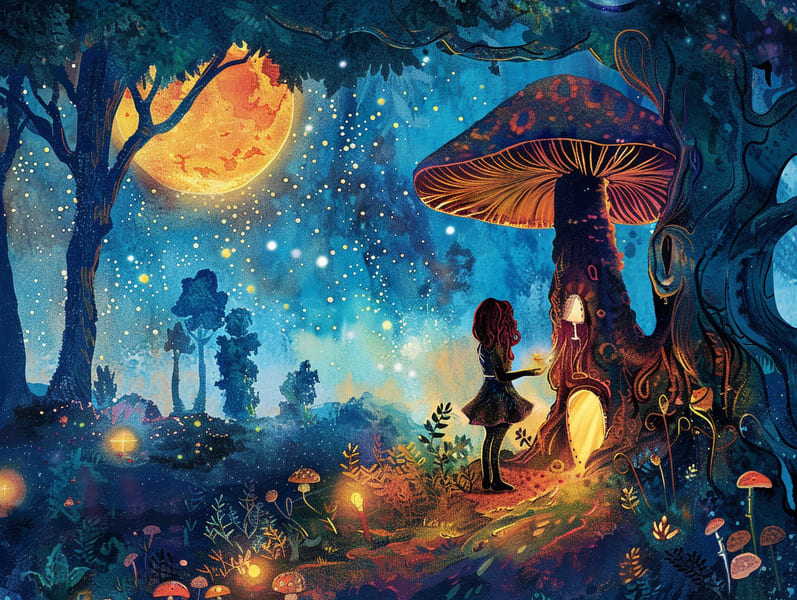
Grimm's fairy tales have ancient roots. These narratives have been passed down from one generation to the next centuries before they were ever written down. They emerged from a variety of traditions, including Indigenous traditions. They were initially narrated among adults, often carrying themes and messages aligned with the societal norms and beliefs of the time.
The Grimm brothers, the two Grimm brothers, were among the first to collect many of these beloved stories. Their compilation, "Grimm's Folk Tales," included narratives like "Cinderella," "Hansel and Gretel," and "Little Snow White," which have since become pillars in the world of iconic fairy tales. Similarly, Hans Christian Andersen's imaginative stories, such as "The Little Mermaid," and "The Duckling's Story," have captivated hearts worldwide, guaranteeing their place in the pantheon of famous fairy tales.
Despite being ancient, these stories remain as pertinent as ever, especially as kids' bedtime tales. These magical stories are now available in many formats, including vividly illustrated books, magical animations, and online fairy tales.
Their ongoing significance can be credited to several captivating elements:
Crucial Morals: Ancient fairy tales often provide important moral lessons. Stories like "The Shepherd Boy and the Wolf" teach the importance of honesty, while "The Tortoise and the Hare" highlight the virtues of determination and humbleness. These tales offer young readers clear distinctions between good and bad, helping to shape their moral compass in a mild yet important way.
Compassion and Knowledge: Classic fairy tales frequently feature individuals facing challenges and problems, provoking young readers to relate with their struggles and applaud their triumphs. For instance, "The Story of Beauty and the Beast" emphasizes the merit of looking past the exterior to perceive the inner core of a being, promoting sympathy and awareness.
Cultural Awareness: Many classic fairy tales are deeply ingrained in the cultural contexts from which they came. Learning from these narratives can provide captivating looks into different heritages, fostering a sense of global understanding and respect.
Creativity and Fantasy: The magical elements in classic fairy tales—enchanted objects—ignite children’s creative minds. These tales bring readers to fantastical realms, fostering fantastical thinking and a sense of delight that stays a lifetime.
Ancient fairy tales are not only charming but also informative. They function as magical tools in developing various mind and heart abilities in the young. When timeless fairy tales are recited, they improve language proficiency by bringing new linguistic read more elements and complicated sentence structures. This practice also enhances auditory perception and attentiveness, as young readers stay focused, expectant to see what happens next.
Furthermore, discussing the themes and characters of old fairy tales can foster critical thinking and evaluative skills. Young readers are educated to pinpoint patterns, forecast, and realize cause and effect. These contemplations also advance kids voice their thoughts and feelings, fostering their emotional intelligence.
In today’s cyber age, the accessibility of digital fairy tales has made these stories more obtainable than ever. Digital sites and online apps offer ample collections of popular fairy tales that can be explored or listened to anytime, anywhere. Fairy tales recited are particularly popular, offering an engaging way for young ones to delight in these captivating stories. Spoken stories and spoken videos take characters and settings to life, often supplemented by mesmerizing sound effects and tunes that heighten the tale journey.
The lasting allure of ancient fairy tales lies in their ability to shift to modern society while sustaining their main lessons. Contemporary renditions of these stories often highlight more representative protagonists and modern settings, making them relatable to today’s audience. However, the main ideas of bravery, kindheartedness, and fair play remain unchanged, continuing to affect audiences of all ages.
Ancient fairy tales also offer a sense of ease and closeness. They present a methodical narrative with a evident beginning, middle, and end, often closing with the culmination of conflicts and the triumph of justice over injustice. This assuredness can be comforting for young ones, bringing a sense of assuredness in an fluctuating world.
Traditional fairy tales continue to entrance and train new generations, maintaining their splendor and importance in modern society. As bedtime stories for kids, they confer upon a perfect blend of wonder and wisdom, enhancing moral values, empathy, and creativity. The presence of digital fairy tales and the well-liked nature of fairy tales read aloud ratify that these ancient tales remain reachable to new generations.
By maintaining and broadcasting these tales, we continue to praise the rich tapestry of fables and cultural heritage. Whether you are exploring a vibrantly illustrated book, experiencing a online library, or playing an audio story, the fascination of ancient fairy tales is always within reach. These fairy tales convey of the consistent power of narratives and its ability to draw us together across centuries and lands.
Even if you are experiencing a beautifully illustrated book, browsing a electronic collection, or hearing an narrated book, the splendor of ancient fairy tales is always within reach.
These narratives point out of the endless presence of fairy tales and its ability to link us across eras and regions, establishing a link that charms and informs alike.